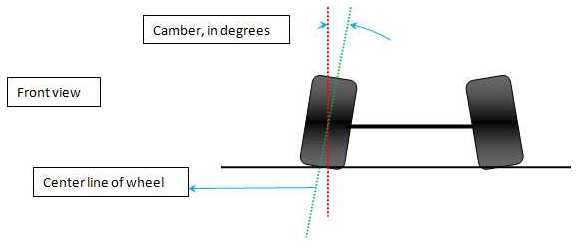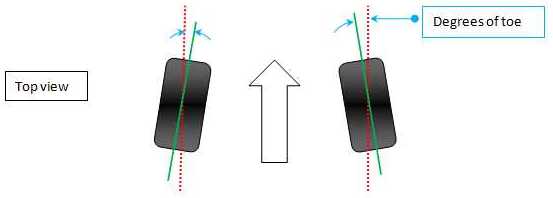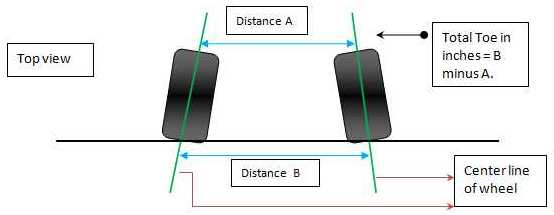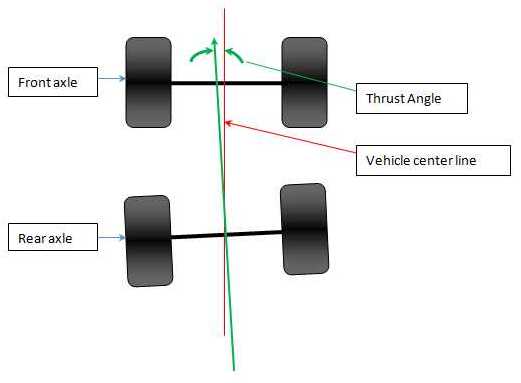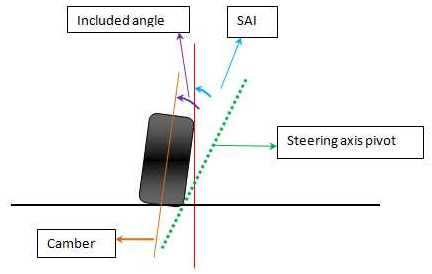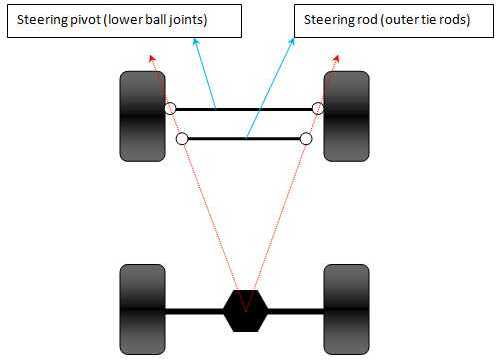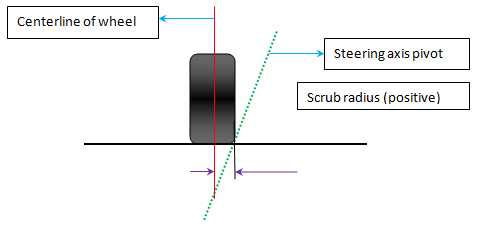Caster (in degrees): The angle between a line drawn through the upper mounting points (green line) and the lower mounting point (ball joint) and a true vertical line as viewed from the side of the car. Most vehicles have positive caster.
Camber (in degrees): The angle between a line drawn through the top and bottom of the tire (green line) and true vertical as viewed from the front.
Toe (in degrees): The angle between a line pointing straight ahead (Thrust angle) and a line going through the center of the tire, back to front, as view from above.
Toe (in inches): As above, but distance between the rear of the tires at the point where the green line intersects them and the distance between the fronts of the tires where the green line intersects. See Degrees to inches article.
Thrust Angle: The angle that the rear wheels are pointing in relation to the center line of the vehicle. 0 degrees is the most desirable setting, and any angle other than that can cause “dog-tracking”. A positive thrust angle is one in which the rear axle is pointing towards the passenger side of the vehicle.
Steering Axis Inclination (SAI): SAI is the measurement in degrees of the steering pivot line from true vertical when viewed from the front of the vehicle. The steering pivot line is an imaginary line drawn from the lower suspension pivot point (i.e., lower ball joint) to the center of the upper suspension pivot point (upper ball joint on double A-arm, upper strut mount on strut). Most alignment machines have a way to measure SAI; however it is not separately adjustable. The most likely cause for SAI being out of specification is bent parts, which should be replaced to correct the condition.
Included Angle (IA): Included angle is the angle formed when SAI and camber are added together.
Ackermann: The angle as measured from the center of the rear axle to the center of the lower steering pivot (usually the lower ball joint), as it bisects the outer tie rod end. Ackerman steering geometry is designed to solve the problem of wheels on the inside and outside of a turn needing to trace out circles of different radii. With a perfect Ackermann, at any angle of steering, the center points all of the circles traced by both front wheels will be the same. Most modern cars do not use perfect Ackermann for reasons of manufacturing compromises. Below is an illustration of perfect Ackermann geometry.
Bump Steer: The phenomenon where a vehicle’s steering will gain or lose toe when the front suspension is compressed. As it “bumps”, it “steers”. This can cause a car to “darty” and wonder on bumpy road surfaces.
Scrub Radius: The intersection of a line drawn through the steering axis, and a vertical line drawn through the center-line of the wheel; as seen from the front of the vehicle. Scrub radius is positive when the center-line of the wheel lies outside the projected steering axis (lines will meet below the road surface), and is negative when the center-line of the wheel is inside the projected steering axis (lines will meet above the road surface). Scrub radius is most often changed when aftermarket wheels are installed, or when wheel spacers are added, that is, the offset of the wheel was changed. Below is an example of positive scrub radius.



